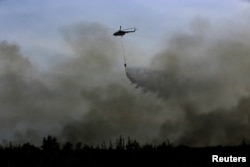Indonesia is bracing for more forest fires after hundreds of "hot spots” were detected last week, marking a new high point in this year's record.
For Indonesia, this forest fires have become a predictable and intractable annual problem.
Five provinces (Riau, Jambi, South Sumatra, West Kalimantan and South Kalimantan) have declared states of emergency, and one Sumatra official called for people to be shot if they set fires. Major cities like Pontianak, West Kalimantan and Pekanbaru, Sumatra, have been intermittently choked with haze from 282 forest fires.
The question that remains in 2017 is why progress on this persistent issue [is] proving so difficult. 2015 was a record year for forest fires, as a drought linked to the El Niño climate cycle created unprecedented haze in the region, which stretched to include Singapore and Malaysia.
But two years later, in a “normal” year that does not harbor El Niño or unusual drought, forest fires continue to burn and have spread to provinces that typically do not experience them, like Aceh.
Environment Minister Siti Nurbaya Bakar said on Monday she proposed a meeting with President Joko “Jokowi” Widodo to address the issue, but it likely is too late for substantial intervention at the federal level during the current dry season, which will last at least through September.
“The good news is that more progress is being made at the province and district level ... in part since they have less going on than the national government,” said Jenna Jadin, an environmental specialist at the U.N. Office of Project Services in Jakarta. “Because of the 2015 forest fires and what a huge disaster they were, it really got local, district, and provincial governments to wake up and realize the imperative for them to protect their land better.”
Illegal activities
“The reason the ‘ground is on fire’ is because huge chunks of Indonesian land lies upon peat, which is flammable like coal,” said Jadin. Peat is a layer of densely packed, partially decayed organic matter, and half of the world’s tropical peat lands are in Indonesia. In 2015, after its landmark year of haze, Indonesia banned the use of fire to clear peat lands, but the practice continues.
Sutopo Purwo Nugroho, a spokesperson for the Disaster Management Agency, said this week “hot spots were detected on private plantation land, community-owned land, and in national parks, in hard-to-reach locations.”
It has been difficult for the government to eradicate slash-and-burn practices, particularly by palm oil companies because the country is so large and decentralized, and because companies use a variety of middlemen and local groups to actually set the fires.
Signs of progress
Some provinces have been successfully experimenting with “water bombing” — dropping water from planes over smoking forests to contain forest fires. In Riau, Sumatra, aerial fire fighters have dropped more than 21 billion liters of water since January, according to the Straits Times.
The Jokowi administration also has been proactive since 2015 in legislating against the worst corporate offenders behind the fires.
Jokowi, who studied forestry in college, enacted a moratorium on peatland concessions after 10 people died in the 2015 haze, and approved a two-year extension on it just this past May.
The problem is the hydra-like nature of the fires: even as provinces like Riau develop task forces and attack methods, new provinces like Bangka Belitung have no such institutional knowledge.
“For me, this is worrying because these regions are unlike other regions, which already have a task force [to handle forest fires],” Environment Minister Siti told reporters recently.
Diminished quality of life
Agus, a father of two who sells fruit juice in Pontianak, West Kalimantan, said every summer in recent memory has been like a recurring nightmare.
“I don’t know what to do — it seems to happen every year, and it keeps getting worse,” he said in late July in Pontianak, as the haze started to set in for the evening. “I worry about raising my kids here but I don’t know where we could move. Everywhere in this area has the same problem.”
West Kalimantan had the most hot spots in Indonesia as of last week -150.
Dozens have been hospitalized due to haze this summer, and some schools have had to close, like in Meulaboh, Aceh. It has echoes of 2015, when school closures in Malaysia, Indonesia, and Singapore affected millions of students and caused about 140,000 reported respiratory illnesses in Indonesia alone.
“We will be getting a bad year like 2015 again some time soon,” said the U.N.'s Jadin, “and because of climate change, those types of years will be much more frequent.”









